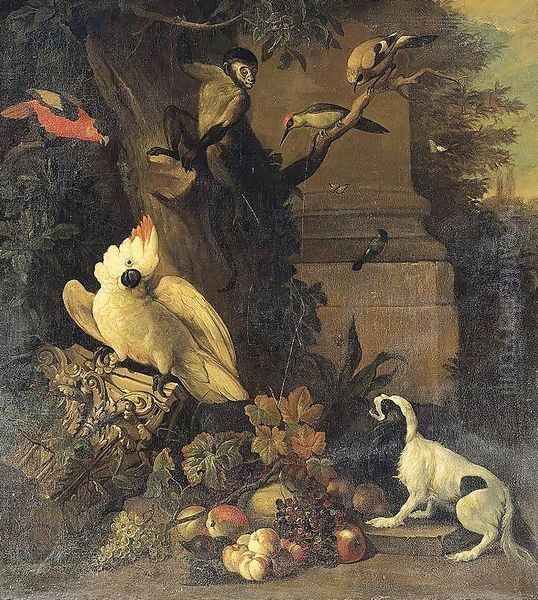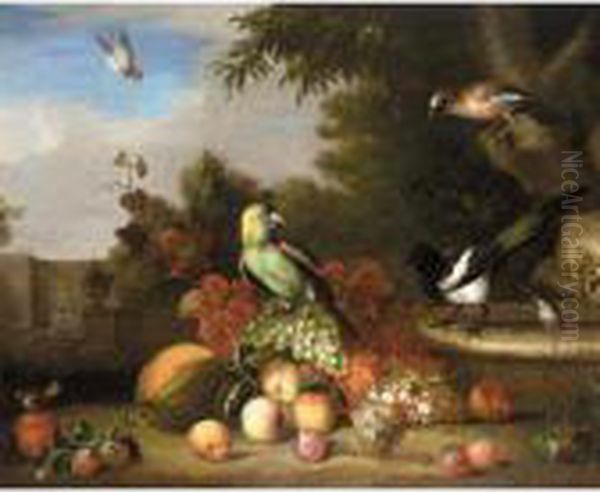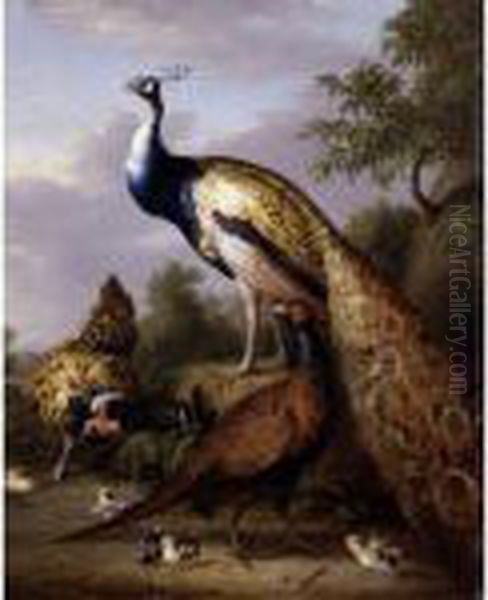Tobias Stranover stands as a notable figure in the landscape of early 18th-century English art, celebrated for his vibrant and detailed depictions of birds, animals, and fruit. Though perhaps not as universally recognized as some of his contemporaries, his contribution to the genres of still life and animal painting in England was significant, bringing a unique vibrancy and exoticism that captivated patrons of his time. His work, often created in collaboration with his esteemed father-in-law Jacob Bogdani, filled a niche and offered a fresh perspective that complemented the existing traditions.
Early Life and Continental Roots
Born in 1684 in Nagyszeben, a town in Transylvania, Kingdom of Hungary (now Sibiu, Romania), Tobias Stranover, or Stranovius as he was sometimes known in Latinized forms, was immersed in an artistic environment from a young age. His father, Jeremias Stranover, was himself a painter, suggesting that Tobias received his initial artistic training within the family. This familial connection to the arts likely provided a foundational understanding of technique and composition, which he would later refine through further study and practice.
The artistic environment of Transylvania at this time, while perhaps not as central as Paris or Rome, was part of a broader Central European cultural sphere that was receptive to influences from both Western and Eastern Europe. Artists in this region often blended local traditions with prevailing international styles, particularly those emanating from the Netherlands and Germany, which were renowned for their mastery of still life and genre painting. It is probable that young Stranover was exposed to such influences early in his development.

Before making his way to England, Stranover is believed to have spent time in Germany and possibly the Netherlands, further honing his skills. These regions were powerhouses of still life and animal painting. Dutch artists like Melchior d'Hondecoeter, with his grand depictions of exotic birds in park-like settings, and Jan Weenix, known for his elaborate game pieces and hunting scenes, had set a high standard. Similarly, German painters such as Abraham Mignon, who specialized in intricate flower and fruit compositions, contributed to a rich visual culture that Stranover would have undoubtedly absorbed. These experiences would have broadened his technical repertoire and thematic interests, preparing him for his eventual career in London.
Arrival in England and Artistic Milieu
Tobias Stranover eventually made his way to England, settling in London, which was rapidly becoming a major European cultural and economic hub. The exact date of his arrival is not precisely documented, but it was likely in the early 1700s. London at this time offered considerable opportunities for artists, particularly those with specialized skills. The aristocracy and a growing affluent merchant class were keen patrons of the arts, eager to adorn their townhouses and country estates with paintings that signified wealth, taste, and an interest in the wider world.
In London, Stranover's life and career became closely intertwined with that of Jacob Bogdani (c. 1658–1724), another Hungarian-born artist who had already established a successful career in England as a painter of exotic birds and still lifes. Stranover married Elizabeth Bogdani, Jacob's daughter (or, according to some sources, granddaughter, though daughter is more commonly cited for the timeline of collaboration). This familial connection also became a professional partnership, with Stranover working closely with Bogdani and absorbing much of his style and subject matter.
The English art scene in the early 18th century was diverse. Portraiture, dominated by figures like Sir Godfrey Kneller, was highly fashionable. Historical and mythological scenes, championed by artists like Sir James Thornhill, adorned the ceilings and walls of grand buildings. However, there was also a significant market for decorative paintings, including landscapes, marine art, and, crucially for Stranover, still life and animal subjects. The prevailing taste was influenced by Dutch Golden Age painting, and artists who could emulate or adapt these styles found ready patrons.
Collaboration with Jacob Bogdani
The collaboration between Tobias Stranover and Jacob Bogdani was a defining feature of Stranover's career. Bogdani was a highly respected figure, patronized by Queen Anne and other members of the nobility. He specialized in compositions featuring a dazzling array of exotic birds, often set against lush garden or parkland backdrops. These birds, including parrots, macaws, cockatoos, and various waterfowl, were often sourced from royal menageries or private collections, reflecting a growing interest in natural history and the exotic wonders being brought to Europe through trade and exploration.

Stranover worked as an assistant and collaborator to Bogdani, and their styles are often very similar, sometimes making definitive attribution challenging. It is believed that Stranover often painted parts of Bogdani's larger compositions or created works in Bogdani's manner under his guidance. This partnership allowed Stranover to refine his skills in depicting the vibrant plumage of exotic birds and the varied textures of fruits and foliage, hallmarks of Bogdani's oeuvre.
Together, Stranover and Bogdani contributed significantly to a genre that brought a sense of "lightness and exoticism" to English painting. Their works stood in contrast to, or perhaps complemented, the more robust and sometimes rustic animal paintings of earlier English artists like Francis Barlow (c. 1626–1704), known for his illustrations and depictions of British wildlife, or the somewhat more sombre bird paintings of Marmaduke Cradock (c. 1660–1717). While Barlow and Cradock focused more on native fauna and a more traditional approach, Bogdani and Stranover introduced a brighter palette and a fascination with species from distant lands.
Stranover's Artistic Style and Thematic Focus
Tobias Stranover developed a distinctive style characterized by vivid coloration, meticulous attention to detail, and a lively sense of composition. His paintings often teem with life, showcasing a variety of birds, animals, and fruits arranged in dynamic, often asymmetrical, groupings. He had a keen eye for the textures of feathers, the sheen of fruit, and the delicate structure of flowers, rendering them with considerable skill.
His primary subjects were birds, both exotic and domestic, often shown in animated interaction. Parrots, with their brilliant plumage, were frequent subjects, as were peacocks, pheasants, chickens, and ducks. These were typically set in outdoor environments – parklands, gardens, or against classical architectural elements – creating a sense of cultivated nature. Monkeys and dogs sometimes appeared in his compositions, adding a further touch of the exotic or a narrative element.
Fruit still lifes were another important aspect of Stranover's output. He depicted luscious arrangements of grapes, peaches, plums, melons, and other fruits, often combined with flowers and occasionally insects or small birds. These compositions demonstrate his understanding of form, light, and shadow, creating a sense of abundance and sensory appeal. His later works are noted for being particularly refined and detailed, showing a maturation of his technique.

Stranover's knowledge of flora and fauna from around the world was evident in his paintings. This reflected the era's burgeoning interest in natural history, fueled by exploration and the establishment of botanical gardens and menageries. His paintings catered to this curiosity, offering viewers a glimpse of the beauty and diversity of the natural world, often enhanced by an artist's imaginative arrangement. Other artists working in similar veins in or influencing England included Peter Casteels III, a Flemish painter who also specialized in birds and flowers and worked in England, and Luke Cradock, son of Marmaduke, who continued his father's tradition of bird painting.
Representative Works
Several works are attributed to Tobias Stranover, showcasing his characteristic style and subject matter. While a comprehensive catalogue raisonné might be elusive, key examples highlight his talents:
One notable type of composition is exemplified by titles such as "A Monkey, a Dog and Various Birds in a Landscape." Paintings with such titles typically feature a lively assembly of creatures. The monkey, often a symbol of mischief or a curious observer, adds an exotic touch. The dog might be a spaniel or other breed popular at the time. The birds would include a mix of colorful parrots, domestic fowl, and perhaps game birds, all rendered with Stranover's characteristic attention to feather detail and animated poses. The landscape setting provides depth and context, often suggesting a well-tended estate.
"Birds in a Park" or "Birds in a Parkland Setting" represents another common theme. These works often depict a variety of birds, both native and exotic, congregating near a fountain, classical ruins, or within a lush, wooded area. Peacocks, with their iridescent plumage, are frequently featured, symbolizing splendor and immortality. Such scenes were popular for their decorative qualities and their ability to evoke the leisurely atmosphere of aristocratic estates.
A specific example often cited is "A Peacock, Hen and Cock Pheasant in a Landscape." This type of painting focuses on game birds and ornamental fowl, showcasing their distinctive forms and colors. The peacock, a recurring motif, would be rendered with particular care to capture the intricate patterns of its train. The pheasant, another bird prized for its beauty and as game, would also be depicted with naturalistic detail.
"Still Life with Fruit and Birds" is a title that encompasses many of Stranover's works. These paintings combine the richness of fruit still life with the liveliness of animal subjects. A typical composition might feature a stone ledge or table laden with grapes, peaches, plums, and perhaps a cut melon, with small birds like finches or tits perched nearby, sometimes pecking at the fruit. These works demonstrate Stranover's skill in balancing different textures and colors, creating harmonious and visually appealing arrangements. The influence of Dutch masters like Jan van Huysum or Rachel Ruysch, renowned for their exquisite fruit and flower pieces, can be discerned in the meticulous rendering and opulent feel of these still lifes.
It is important to note that titles can vary, and many works by artists of this period are known by descriptive titles assigned by later collectors or institutions. However, the consistent elements in Stranover's attributed works are the vibrant depiction of birds, often exotic, detailed rendering of fruit, and dynamic, decorative compositions. His work, while perhaps not reaching the sublime heights of a Chardin or the dramatic intensity of a Snyders, possessed a charm and decorative appeal that was highly valued.
The Broader Context of European Still Life and Animal Painting
Stranover's work should be seen within the broader European tradition of still life and animal painting, which had reached a zenith in the 17th century, particularly in the Netherlands and Flanders. Artists like Frans Snyders and Jan Fyt were masters of large-scale hunting scenes and market stalls teeming with game and produce. Melchior d'Hondecoeter, as mentioned, specialized in "bird-concerts" and menagerie scenes. These artists established a visual language and technical standard that influenced painters across Europe.
In France, Jean-Baptiste Oudry and Alexandre-François Desportes were contemporaries of Stranover, also specializing in animals, hunting scenes, and decorative still lifes, often for royal patrons. While Stranover's scale was generally more modest, he shared with these artists an interest in accurate depiction combined with decorative effect. The English sporting art tradition, which would later flourish with painters like George Stubbs and James Seymour, was also developing during Stranover's lifetime, indicating a widespread English interest in animal subjects, though Stranover's focus was less on the hunt and more on the intrinsic beauty and exoticism of his subjects.
The demand for Stranover's type of painting was also fueled by the design of early 18th-century interiors. Large decorative paintings were often commissioned as overmantels or to be set into wall paneling, contributing to the overall decorative scheme of a room. Stranover's colorful and lively compositions were well-suited to this purpose. His patrons would have included members of the nobility and gentry who were cultivating gardens and sometimes keeping aviaries, making his subject matter particularly appealing.
Anecdotes and Later Life
Specific, detailed anecdotes about Tobias Stranover's personal life are relatively scarce, a common situation for many artists of his era who were not of the absolute first rank of fame like a Hogarth or a Reynolds. Much of what is known is inferred from his artistic output, his association with Bogdani, and general records of artists working in London at the time.
One interesting note from the provided information mentions a still life by a "follower" of Stranover, depicting a basket of various flowers (peonies, roses, irises, orchids, daisies) and fruits (grapes, apples, honeysuckle, cherries) on a table, created in London between 1684 and 1731. While not by Stranover himself, this indicates that his style, or the general style of decorative still life he practiced, had an influence and was emulated by others. It speaks to the popularity of this genre.
Tobias Stranover continued to work in London, producing his characteristic paintings of birds and still lifes. He passed away in London in 1756. His death marked the end of a career that had significantly contributed to the vibrancy of decorative painting in England during the early Georgian period.
Collections and Legacy
Works by Tobias Stranover are found in various public and private collections. Museums in Hamburg, Dresden (Germany), and Budapest (Hungary) are noted as holding examples of his paintings. This distribution reflects the international appreciation for still life and animal painting, and perhaps the movement of artworks through trade and collecting over the centuries. His paintings also feature in numerous British private collections, particularly those housed in historic country houses, where they may have remained since their original acquisition.
Stranover's legacy lies in his contribution to the English tradition of animal and still life painting. Alongside Jacob Bogdani, he helped popularize a style that was rich in color, detail, and exotic subject matter. He brought a continental European sensibility to the English art scene, blending influences from Hungarian, German, and Dutch traditions. While he may not have been a radical innovator, he was a highly skilled practitioner whose works provided delight and aesthetic pleasure to his contemporaries and continue to be appreciated for their charm and artistry.
His paintings serve as valuable documents of the taste and interests of the early 18th century, reflecting the period's fascination with the natural world, the vogue for exoticism, and the desire for decorative art to enhance domestic interiors. He was part of a wave of immigrant artists, including figures like Michael Dahl and later Philip Mercier, who enriched the British art scene. In the specific realm of bird and still life painting, Stranover holds a secure place as a talented and productive artist whose work brightened the homes of many English patrons. His art provides a colorful window into the aesthetic preferences of early Georgian England, a period of growing prosperity and expanding horizons.